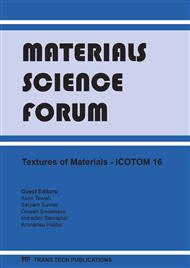[1]
M.C Flemings, G.E. Nereo, Trans. AIME, 242 (1968) 50-55.
Google Scholar
[2]
A.J. Beaudoin, W.A. Cassada, Proc. TMS Spring Meeting, (1998).
Google Scholar
[3]
R.H. Srone, J.A. Psioda, Met. Trans. A, 6A (1975) 668-670.
Google Scholar
[4]
N.U. Deshpande, Metal. Trans. A, 29A (1998) 1191-1201.
Google Scholar
[5]
J. Gjonnes, C.J. Simensen, Acta Metal. 18 (1970) 881.
Google Scholar
[6]
D. Kuhlmann-Wilsdorf, N. Hansen, Scripta Metall. Mater. 25 (1991) 1557-1562.
Google Scholar
[7]
J.F. Nye, Acta Metall, 1 (1953) 153-163.
Google Scholar
[8]
W. Pantleon, Acta Mater. 46 (1998) 451-456.
Google Scholar
[9]
W. Pantleon, Mater. Sci. Eng. A319-321 (2001) 211-215.
Google Scholar
[10]
D.P Field, H. Weiland, Mat. Sci. Forum 157-162 (1994) 1181-1188.
Google Scholar
[11]
P. Trivedi, D.P. Field, H. Weiland, Int. J. of Plasticity 20 (2004) 459-476.
Google Scholar
[12]
G. Winther, X. Huang, N. Hansen, Acta Mater. 48 (2000) 2187-2198.
Google Scholar
[13]
A. Arsenlis, D.M. Parks, R. Becker, and V.V. Bulatov, J. Mech. Phys. Sol, 52 (2004) 1213-1246.
Google Scholar
[14]
E. Kroner, Appl. Mech. Rev. 15 (1962) 599.
Google Scholar
[15]
B. Bay, N. Hansen, D. Kuhlmann-Wilsdorf, Mater. Sci. Eng. A113 (1989) 385-397.
Google Scholar
[16]
D. Kuhlmann-Wilsdorf, Mater. Sci. Eng. A113 (1989) 1-41.
Google Scholar
[17]
N. Hansen, Mater. Sci. Tech. 6 (1990) 1039-1040.
Google Scholar
[18]
D.A. Hughes, N. Hansen, Mater. Sci. Tech. 7 (1991) 544-553.
Google Scholar
[19]
B. Bay, N. Hansen, D.A. Hughes, D. Kuhlmann-Wilsdorf, Acta metal. mater. 40 (1992) 205-219.
Google Scholar
[20]
D.A. Hughes, N. Hansen, Metall. Trans. 24A (1993) 2021.
Google Scholar
[21]
S. Panchanadeeswaran, R.D. Doherty, R. Becker, Acta Mater. 44 (1996) 1233-1262.
Google Scholar
[22]
O. Engler, M.-Y Huh, C.N. Tome, Metall. Mater. Trans. A, 31A (2000) 2299-2315.
Google Scholar
[23]
CC Merriman, DP Field and P Trivedi, Mat Sci Eng A494 (2008) 28-35.
Google Scholar
[24]
J.S. Kallend and Y.C. Huang, Proc. Seventh International Conference on Textures of Materials, Netherlands Soc. For Materials Science, 1984, pp.783-786.
Google Scholar
[25]
D.D. Sam and B.L. Adams, Metall. Trans. 17A (1986) 513-517.
Google Scholar
[26]
S.F. Castro, J. Gallego, F.J.G. Landgraf, and H.-J. Kestenbach, Mat. Sci. Eng. A, 427 (2006) 301–305.
Google Scholar
[27]
N. Hansen, X. Huang, W. Pantleon and G. Winther, Phil. Mag. 86 (2006) 3981-3994.
Google Scholar
[28]
H.J. Bunge, Matls. Sci. Forum 157-162 (1994) 13-30.
Google Scholar


